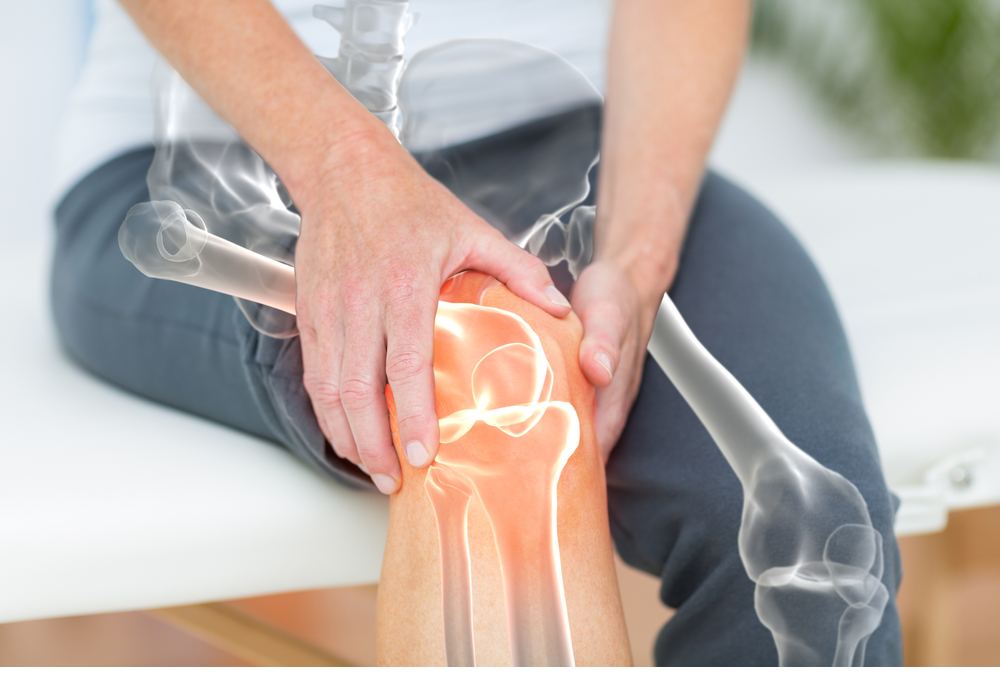
Arthritis refers to inflammation of the joints. You may experience arthritis in only one joint or multiple joints throughout the body. With over 100 different types of arthritis, symptoms and treatment options can vary. Symptoms of arthritis tend to appear gradually, so you want to let your doctor know when you start to notice changes in your joints, like increased pain, swelling, inflammation, and reduced range of motion. Your doctor will be able to determine what type of arthritis you are dealing with and what your options are for continued care. If you are dealing with arthritis pain, talk to your doctor about all your options for symptom relief. From home remedies to surgical procedures, it helps to know all your options and what treatments will work best for you.
What Is Arthritis?
Arthritis is a health condition where you experience inflammation in your joints that can gradually cause pain and damage. The human body has 360 joints that support healthy functioning, movement, and activities. Joints refer to a part of the body where two or more bones come together to support movement. There are six common types of joints in the body: ball and socket, hinge, saddle, pivot, gliding, and condyloid. The joints in your body can range from freely movable to immovable based on their location and purpose. Inside the joints, cartilage and synovial fluid help protect the bones from rubbing against each other and support smooth movements. Different types of arthritis will cause the cartilage or synovial fluid inside of your joints to break down over time, which leads to pain and other symptoms. Arthritis is typically associated with older adults, though different types of arthritis can impact children, teens, and young adults as well. For example, osteoarthritis commonly affects adults over age 50, while rheumatoid arthritis can develop as early as childhood.
Types of Arthritis
Arthritis is a broad term encompassing over 100 different conditions that result in inflammation and stiffness in the joints. Each type of arthritis affects the body in distinct ways, and understanding these variations is crucial for proper diagnosis and treatment. Here are some of the most common types of arthritis:
Osteoarthritis
The most common form of arthritis is osteoarthritis, often referred to as wear-and-tear arthritis. This degenerative joint disease occurs when the cartilage that cushions the ends of bones in the joints gradually deteriorates. As the cartilage wears away, bones begin to rub against each other, leading to pain, swelling, and decreased range of motion. Osteoarthritis commonly affects the knees, hips, hands, and spine. While aging is a significant risk factor, obesity, joint injuries, and genetics can also contribute to its development.
Rheumatoid Arthritis
Rheumatoid arthritis (RA) is an autoimmune disorder where the body’s immune system mistakenly attacks the lining of the membranes that surround the joints known as the synovium. This leads to inflammation that can damage the cartilage and bones within the joint. Rheumatoid arthritis typically affects the joints symmetrically, such as both wrists, both knees, or both hands, and can also impact other systems in the body, including the skin, eyes, lungs, and blood vessels. Early diagnosis and aggressive treatment are essential to manage symptoms and prevent joint damage.
Psoriatic Arthritis
Psoriatic arthritis is a type of arthritis that affects some individuals who have psoriasis, which is a condition that causes red patches of skin topped with silvery scales. This inflammatory arthritis can cause joint pain, stiffness, and swelling. Psoriatic arthritis can affect any part of the body, from the fingertips to the spine, and its severity can vary significantly from person to person. Like rheumatoid arthritis, it is an autoimmune disease, and early intervention can help control its progression and prevent joint damage.
Gout
Gout is a type of inflammatory arthritis characterized by sudden, severe attacks of pain, redness, and tenderness in the joints. Gout most often affects the joint at the base of the big toe. It is caused by the accumulation of urate crystals within the joint, resulting from high levels of uric acid in the blood. Factors that can increase uric acid levels include diet, obesity, certain medical conditions, and genetics. Gout can be effectively managed with lifestyle changes and medications that reduce uric acid levels and inflammation.
In addition to these common types, there are many other forms of arthritis, each with its unique causes and characteristics. These include spondylitis, juvenile arthritis, lupus, and reactive arthritis, among others. While less common, these types also contribute to the overall burden of arthritis, which highlights the need for personalized treatment strategies for each person. Understanding the diversity of arthritis types helps in developing better diagnostic tools, treatment plans, and ultimately, improving the quality of life for people living with this condition.
Symptoms of Arthritis
The most common symptoms of arthritis include joint pain, swelling, and stiffness. Many people report feeling more painful symptoms in the morning or after standing up after resting for a while. Arthritis may first develop as soreness in your joints, and you might notice a slight change in your ability to complete normal activities. As arthritis develops, light discomfort can turn into serious pain that affects your daily routines and keeps you from participating in hobbies or activities you enjoy. People with osteoarthritis may also experience a reduced range of motion that might go away once they get moving. You may notice clicking or popping sounds when you engage certain joints. Osteoarthritis in the hands and fingers can lead to bony growths or slight deformities, while osteoarthritis in the knees can create a scraping or grating sensation.
Symptoms of rheumatoid arthritis can vary slightly from osteoarthritis because this type of arthritis is actually an autoimmune disorder. With rheumatoid arthritis, the body’s immune system ends up attacking its own tissues inside the body, like the synovial fluid that lubricates your joints. If you have rheumatoid arthritis, you may notice symptoms first develop in your hands and feet before extending into other joints. Rheumatoid arthritis can also cause fatigue, a low-grade fever, and a low red blood cell count. People with rheumatoid arthritis typically experience symptoms of arthritis in joints on both sides of the body. You may also have inflammation that affects the eyes, mouth, heart muscles, and blood vessels.
How Arthritis Is Diagnosed
Talk to your doctor about any pain and discomfort you experience in your joints. Your doctor will review your medical history and also perform a physical exam to assess the joints for tenderness, warmth, redness, and any reduced range of motion. You may talk to your primary care doctor when you first start to experience symptoms of arthritis, and they may refer you to a specialist as the condition progresses. Different tests will help determine the type of arthritis you have and your next steps for symptom relief and treatment. A blood test can check for antibodies that can help diagnose certain types of arthritis. Your doctor may also recommend diagnostic imaging tests to get a better look at the affected joints. X-rays will show more detailed images of your bones and joints, which can help rule out other potential issues like a bone fracture or bone spur. A CT scan or MRI will offer a more detailed set of images that show soft tissues like cartilage and nearby muscles, tendons, and ligaments that support your joints.
Treatment Options for Arthritis

In some cases, lifestyle modifications and pain management techniques can help you manage your arthritis symptoms. Other times, you may need a surgical procedure to restore healthy joint functioning. You can talk to your doctor about whether your type of arthritis can be scraped out of your joints and what type of treatment options will work best for you. Here are five examples of how to treat arthritis.
Lifestyle Changes
Your doctor will typically recommend more conservative approaches to treat your arthritis before moving on to more invasive procedures. One way to manage your symptoms of arthritis at home is by implementing some changes to your lifestyle. This may include engaging in regular low-intensity exercise like swimming or water aerobics to keep your joints moving and strengthen nearby muscles. Eating a nutrient-rich diet can also improve your symptoms and help you avoid an increase in inflammation depending on what foods you eat. Your doctor may also recommend weight loss, if needed, to help reduce pressure and strain on your affected joints.
Medications & Supplements
Your doctor may recommend medications and supplements to help ease your pain and manage your symptoms. Over-the-counter anti-inflammatory medications like NSAIDs can also help reduce pain and discomfort caused by arthritis. Vitamins and supplements have also shown promise in relieving arthritis symptoms like pain and stiffness in joints. Certain supplements may contain components of cartilage that can help replenish worn-down cartilage in your joints. When over-the-counter options do not help in reducing your pain, your doctor may also recommend steroids for a brief period of time to help reduce inflammation.
Physical Therapy
Work with a physical therapist to improve your overall strength and mobility, so your joints are well supported. Physical therapy will introduce you to stretches, exercises, and other therapeutic techniques that allow you to take an active role in your pain management and treatment. Strengthening the muscles that support joints affected with arthritis can help manage your pain, reduce stiffness, and help prevent a loss in the range of motion. A physical therapist will also talk to you about stretches, exercises, and other activities you can do at home and in between sessions to help you build strength and improve your mobility. Exercises that also focus on flexibility and balance can help you stay mobile and help prevent falls. Physical therapy can also provide you with the tools to successfully recover from various surgeries, including scraping arthritis from the knee.
Joint Reconstruction
Sometimes, the best way to relieve your arthritis pain is with surgery. Ask your doctor, “Can arthritis be removed?” for your specific situation. Joint reconstruction refers to a type of surgery that repairs damaged tissues. A joint reconstruction can involve an arthroscopic surgery, which is a minimally invasive procedure where your surgeon makes tiny incisions around the joints and uses small instruments and a camera inside to make minor adjustments to affected joints. During a procedure like this, your doctor may remove bone spurs, trim the cartilage, or release pressure from a tight ligament supporting the nearby joint.
Joint Replacement
A full joint replacement surgery typically only occurs with large joints like the hips, shoulders, or knees. A surgeon will usually only recommend joint replacement when your symptoms have failed to respond to other conservative approaches. This type of surgery involves removing the damaged joint and replacing it with a prosthetic joint made of durable plastic and metal. Sometimes the only way to effectively remove your pain for good is to get joint replacement surgery. This surgery is more common in older adults with late-stage osteoarthritis. A typical joint replacement will last at least ten years.
When to Consider Surgery for Arthritis

Are you wondering, “Can you have surgery to remove arthritis?” Surgical intervention may be necessary to remove diseased tissues in your joints and help reshape joints so they can function better. While surgery cannot remove arthritis completely, it can address specific issues caused by the disease. Several surgical options are available depending on the severity and location of the arthritis. Surgery for arthritis can help redistribute the load on your joints so you can recover mobility. A surgical procedure can also remove inflamed synovial tissue or cartilage, like scraping arthritis out of a joint. Removing damaged tissue with a less invasive surgical procedure will typically involve a faster recovery than a full joint replacement. Talk to your orthopedic surgeon about your different options for treatment, including effectiveness and recovery time.
Rely on the Team at AICA College Park for Arthritis Care
Visit AICA Orthopedics in College Park to learn more about the treatment options available for managing your arthritis pain. We will provide you with detailed answers to your questions, like “can arthritis be removed by surgery?” Each patient’s situation is unique, so it is essential to discuss the potential benefits and risks of surgery with a healthcare provider to determine the most appropriate treatment plan. Our team of doctors includes orthopedic surgeons, physical therapists, neurologists, and chiropractors who can help you experience lasting pain relief and return to activities you love.